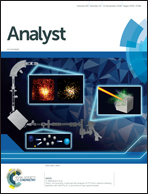Fluid-permeable enzymatic lactate sensors for micro-volume specimen†
Abstract
Sensing of lactate in perspiration provides a way to monitor health and control exercise. The volume of perspiration is miniscule, and the efficient collection of perspiration is desired for its effective sensing. We developed mesh-type enzymatic electrodes fabricated on textile meshes and integrated the meshes into an enzymatic biofuel cell. We tested them as self-powered lactate sensors for a small volume of lactate solution. A fluid-permeable enzymatic anode was fabricated based on an insulating textile mesh that was coated with carbon nanotubes (CNTs) and lactate oxidase. The anode was further coated with polyurethane to increase the linear range by limiting the diffusion of lactate while maintaining the advantages of the original textile mesh, such as flexibility, stretchability, and permeability. Permeability of the mesh-type lactate-oxidizing anode allowed a vertically stacked structure of the anode and a previously developed air-breathing cathode. This resulted in a small overall device size (1 cm2). The mesh-type sensor was tested using a small flow rate of lactate solution, and a moderate linearity of amperometric response for a wide concentration range (5 to ≥20 mM) was confirmed. The fluid-permeable anode and enzymatic biofuel cell show the potential of the sensor for continuous monitoring of lactate in perspiration on skin.



 Please wait while we load your content...
Please wait while we load your content...
